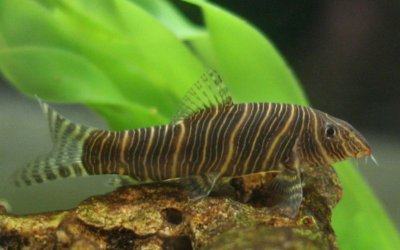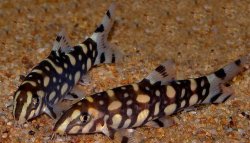I think you two are thinking of different species when you use the common name "Zebra" loach. I do not like using common names for this reason, though sometimes they are faster but only if there is no uncertainty over what species they refer to.
Botia striata is a species that I first encountered as Zebra Loach, and this is one common name for this species used by Loaches Online. This is a very peaceful species for a loach, and a group of five (or more) should do well with peaceful upper fish. You need lots of chunks of wood, preferably something like Malaysian Driftwood, chunks with crevices and tunnels. Photo of this fish below.
There is another species that for the life of me I cannot now think of, that came up in a couple threads some time back as "Zebra" loach, and it is indeed a rough customer. I suspect this is the fish Colin is thinking of; wish I could remember the name.
The Yo Yo Loach was mentioned...this can work, but sometimes this fish gets a bit feisty. The name/species is confusing, but before I sort that out, let me say that a better choice in a very similarly-patterned botine loach is Botia kubotai. Also a photo below of this beauty. Now to the "Yo Yo" for those interested.
The true species is Botia almorhae, not B. lohachata as is often encountered in the literature. This commonly-available loach may be seen under several common names including Reticulated loach, Lohachata Botia, Pakistani Loach, Almorha Loach and Yo Yo Loach probably being the most common. The latter, coined by Ken Childs of Dolphin International fish importers in Los Angeles, comes from the pattern on the fish's side resembling a series of brown "Y" and white "O" markings which is more discernible in young fish.
The exact species name of this fish is still uncertain. Originally it was deemed to be Botia lohachata, the name assigned by B.L. Chaudhuri in 1912, and it is still widely seen under this name. Botia is derived from an Asian word for soldier or warrior. In the early 1990's it was suggested that this species epithet was a synonym for Botia almorhae, the true species, which had been described in 1831 by J.E. Gray. Dr. Maurice Kottelat (2004), an acknowledged authority on this family, assigned the name B. lohachata as a synonym of B. almorhae and not a distinct species in his major revision of the genus which he separated into seven genera. More recently, Kottelat (2012) and several other ichthyologists have accepted B. lohachata as a distinct species.
Steven Grant (2007) has proposed that B. almorhae may in fact consist of five distinct but closely-related species:
Botia almorhae Gray, 1831
Botia birdi Chaudhuri, 1909
Botia lohachata Chaudhuri 1912
Botia sp. "Kosi", possibly a variant of B. almorhae
Botia sp. "Teesta", possibly a variant of B. almorhae
The striking similarity in pattern among these fish certainly makes this feasible; the authoratative Catalog of Fishes (Eschmeyer) of the California Academy of Sciences--Ichthyology has accepted the validity of the first three distinct species. The authors of Loaches Online accept B. almorhae as the species of the subject fish. The occurrence in Pakistan is restricted to the species B. birdi described by Chaudhuri in 1909.



